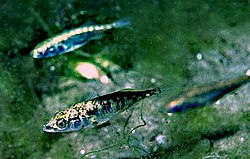| Gasterosteoidei Temporal range: | |
|---|---|
 | |
| Three-spined sticklebacks, Gasterosteus aculeatus | |
| Scientific classification | |
| Kingdom: | Animalia |
| Phylum: | Chordata |
| Class: | Actinopterygii |
| Order: | Perciformes |
| Suborder: | Gasterosteoidei Pietsch,1978 [1] |
| Type species | |
| Gasterosteus aculeatus | |
| Families | |
See text | |
Gasterosteoidei is a suborder of ray-finned fishes that includes the sticklebacks and relatives. It belongs to the order Perciformes. [2]

